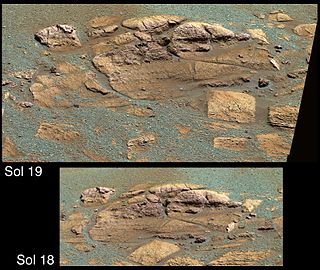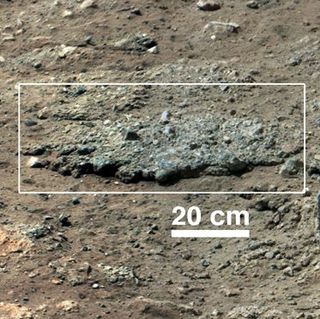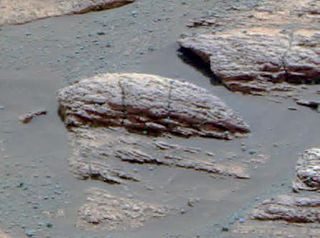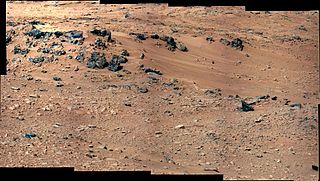 W
WThis is an alphabetical list of named rocks found on Mars, by mission. This list does not include Martian meteorites found on Earth.
 W
WAdirondack is the nickname for Mars Exploration Rover Spirit's first target rock. Scientists chose Adirondack to be Spirit's first target rock after considering another, called Sashimi, that would have been a shorter, straight-ahead drive. Spirit traversed the sandy martian terrain at Gusev Crater to arrive in front of this football-sized rock on January 18, 2004, just three days after it successfully rolled off the lander.
 W
WAeolis Palus is a plain between the northern wall of Gale crater and the northern foothills of Aeolis Mons on Mars. It is located at 4.47°S 137.42°E.
 W
WBarnacle Bill is a 40-centimetre (16 in) rock on Mars in Ares Vallis. It was the first rock on Mars analyzed by the Sojourner rover using its Alpha Proton X-ray Spectrometer. The encounter occurred during Sol 3 of the Mars Pathfinder mission on the surface of Mars and took ten hours to complete.
 W
WBathurst Inlet is a rock on the surface of Aeolis Palus, between Peace Vallis and Aeolis Mons, in Gale crater on the planet Mars. The rock was encountered by the Curiosity rover on the way from Bradbury Landing to Glenelg Intrigue on September 30, 2012 and was named after Bathurst Inlet, a deep inlet located along the northern coast of the Canadian mainland. The "approximate" site coordinates are: 4.59°S 137.44°E.
 W
WBlock Island meteorite, officially named Meridiani Planum 006 shortened as MP 006, was found on Mars by the Opportunity rover on July 17, 2009. It is about 67 centimetres (26 in) across.
 W
WBounce Rock is a football-sized primarily pyroxene rock found within the Margaritifer Sinus quadrangle (MC-19) region of the planet Mars. It was discovered and observed by the Mars Exploration Rover Opportunity in April 2004. The rock was named for the fact that it was struck by Opportunity as the craft bounced to a stop during its landing stage.
 W
WHead (vessel) Evidence for carbonates on Mars was first discovered in 2008. Previously, most remote sensing instruments such as OMEGA and THEMIS—sensitive to infrared emissivity spectral features of carbonates—had not suggested the presence of carbonate outcrops, at least at the 100 m or coarser spatial scales available from the returned data.
 W
WEl Capitan is a layered rock outcrop found within the Margaritifer Sinus quadrangle (MC-19) region of the planet Mars, this geological outcrop was first discovered and observed by the Mars Exploration Rover Opportunity in February 2004. The rock outcrop was named for El Capitan, a topographical mountain lying within the state, Texas.
 W
WGale is a crater, and probable dry lake, on Mars near the northwestern part of the Aeolis quadrangle at 5.4°S 137.8°E. It is 154 km (96 mi) in diameter and estimated to be about 3.5-3.8 billion years old. The crater was named after Walter Frederick Gale, an amateur astronomer from Sydney, Australia, who observed Mars in the late 19th century. Aeolis Mons is a mountain in the center of Gale and rises 5.5 km (18,000 ft) high. Aeolis Palus is the plain between the northern wall of Gale and the northern foothills of Aeolis Mons. Peace Vallis, a nearby outflow channel, 'flows' down from the hills to the Aeolis Palus below and seems to have been carved by flowing water. Several lines of evidence suggest that a lake existed inside Gale shortly after the formation of the crater.
 W
WGoulburn, also known as Goulburn Scour, is a rock outcrop on the surface of Aeolis Palus, between Peace Vallis and Aeolis Mons, in Gale crater on the planet Mars. The outcrop was encountered by the Curiosity rover on landing at the Bradbury Landing on August 6, 2012 and is named after a two-billion year-old sequence of rocks in northern Canada. The "approximate" site coordinates are: 4.59°S 137.44°E.
 W
WHeat Shield Rock is a basketball-sized iron-nickel meteorite found on the Meridiani Planum plain of Mars by the Mars rover Opportunity in January 2005.
 W
WHome Plate is a plateau roughly 90 m across within the Columbia Hills, Mars. It is informally named for its similarity in shape to a baseball home plate. Home Plate is a rocky outcrop that appears to show layered features.
 W
WHottah is a rock outcrop on the surface of Aeolis Palus, between Peace Vallis and Aeolis Mons, in Gale crater on the planet Mars.
 W
WJake Matijevic is a pyramidal rock on the surface of Aeolis Palus, between Peace Vallis and Aeolis Mons, in Gale crater on the planet Mars. The approximate site coordinates are: 4.59°S 137.44°E.
 W
WLast Chance is a layered rock outcrop found within the Margaritifer Sinus quadrangle (MC-19) region of the planet Mars, discovered by the Mars Exploration Rover Opportunity in March 2004. The rock lies within the outcrop near the rover's landing site at Meridiani Planum, Mars.
 W
WLink is a rock outcrop on the surface of Aeolis Palus, between Peace Vallis and Aeolis Mons, in Gale crater on the planet Mars. The outcrop was encountered by the Curiosity rover on the way from Bradbury Landing to Glenelg Intrigue on September 2, 2012, and was named after a significant rock formation in the Northwest Territories of Canada. The "approximate" site coordinates are: 4.59°S 137.44°E.
 W
WMackinac Island meteorite was found on Mars by the Opportunity rover on October 13, 2009.
 W
WThe Mars monolith is a rectangular object discovered on the surface of Mars. It is located near the bottom of a cliff, from which it likely fell. The Mars Reconnaissance Orbiter took pictures of it from orbit, roughly 180 miles (300 km) away.
 W
WMartian soil is the fine regolith found on the surface of Mars. Its properties can differ significantly from those of terrestrial soil, including its toxicity due to the presence of perchlorates. The term Martian soil typically refers to the finer fraction of regolith. So far, no samples have been returned to Earth, the goal of a Mars sample-return mission, but the soil has been studied remotely with the use of Mars rovers and Mars orbiters.
 W
WMartian spherules are the abundant spherical hematite inclusions discovered by the Mars rover Opportunity at Meridiani Planum on the planet Mars.
 W
WN165 is a rock on the surface of Aeolis Palus in Gale Crater on the planet Mars near the landing site of the Curiosity rover. The "approximate" site coordinates are: 4.59°S 137.44°E. On August 19, 2012, the rock was the first target of the rover's laser instrument, ChemCam, which can analyze targets at a distance using a laser and spectrometer. A Twitter feed for the rock was created, featuring an anthropomorphized account of its experiences. Its posts include a humor themed mix of social interaction and Mars content such as "Did you know I was born in a volcano? Basalts like me come from lava. That's why we call it Olympus Mom".
 W
WOileán Ruaidh is a rock discovered on Mars in September 2010 by the Opportunity rover. It is a 45 centimeter wide dark rock thus it is thought to be an iron meteorite. It was given the name Oileán Ruaidh after the Irish language name of Oileán Ruaidh island in County Donegal in Ireland.
 W
WPeace Vallis is an valley network in Gale Crater in the Aeolis quadrangle on the planet Mars; it appears to have been carved by fluids, perhaps water. The valley 'flows' southeast down out of the hills of Gale Crater to Aeolis Palus below near Mount Sharp and is centered 4.21°S 137.23°E. Peace Vallis is near the landing site of the Curiosity rover which started studying the valley in 2012. The name Peace Vallis was officially adopted by the IAU on September 26, 2012.
 W
WPot of Gold is the nickname for a knobby, softball-sized rock in Gusev Crater on Mars. During an examination by the Mars Exploration Rover Spirit on June 25, 2004, Hematite was first detected by Spirit, suggesting a watery past on Mars.
 W
WRocknest is a sand patch on the surface of Aeolis Palus, between Peace Vallis and Aeolis Mons, in Gale crater on the planet Mars. The patch was encountered by the Curiosity rover on the way from Bradbury Landing to Glenelg Intrigue on September 28, 2012. The approximate site coordinates are: 4.59°S 137.44°E.
 W
WRocknest 3 is a rock on the surface of Aeolis Palus, between Peace Vallis and Aeolis Mons, in Gale crater on the planet Mars. The approximate site coordinates are: 4.59°S 137.44°E.
 W
WShelter Island meteorite was found on Mars by the Opportunity rover on October 1, 2009. It is about 27 centimetres (11 in) long.
 W
WTintina is a rock on the surface of Aeolis Palus, between Peace Vallis and Aeolis Mons, in Gale crater on the planet Mars. The approximate site coordinates are: 4.59°S 137.44°E.
 W
WYogi Rock is a rock on Mars that was discovered during the Mars Pathfinder mission in 1997, and named by Geoffrey A. Landis. The rocks found on the mission were named after famous icons and figures, and Yogi Rock was thought to resemble the head of a bear looking away from the spacecraft. As a result, it was named for the famed cartoon character Yogi Bear.